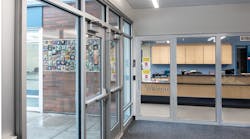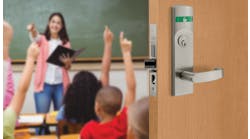For the millions of students who enter school facilities hundreds of times a year, there's not much reason to think about the doors they use to get to classrooms and university lecture halls. They open, they close, and you move down the hall.
But education administrators know that beyond their basic function, doors can be a major factor in a building's security, energy efficiency and accessibility.
So schools and universities that want to provide students and staff with safe, comfortable and welcoming learning environments should pay close attention to maintaining their doors and be prepared to replace defective door systems with upgraded equipment.
As door systems age and get battered from continual use and abuse, defects can develop — hinges become loose, frames get bent, latches don't snap into place. The flaws in a faulty door can allow leaks that undermine a building's heating and cooling systems, and turn what was supposed to be an accessible entrance into a barrier for someone with physical disabilities. A defective door also can lead to security breaches that enable intruders to enter a building more easily.
Caulking and weatherstripping can help prevent energy leaks, but preventing vandalism and intrusion is a greater challenge.
“Uniformly, school officials informed us that securing entry doors are a challenge,” says an audit of school facilities by the Washington, D.C., Office of Inspector General.
The audit cites several strategies for improving door security: access-control systems operated with cards or keypads; electronic door systems that can alert administrators when a door remains open too long and can be locked down from a central administrative site; metal detectors; and camera surveillance.
Many schools are reducing the number of doors, especially those that can be opened from the outside and those situated in less visible parts of a campus. With fewer doors to monitor and maintain, schools can focus their security resources more effectively.
The Federal Emergency Management Agency (FEMA) in its “Primer to Design Safe School Projects in Case of Terrorist Attacks,” encourages schools that are upgrading their facilities to limit the number of doors that are used regularly for entering and exiting a building, while still providing sufficient numbers of emergency exits.
The FEMA report also recommends that schools use hollow steel or steel-clad doors with steel frames and consider blast-resistant doors for high-risk facilities. The strength of the latch and frame anchor should equal that of the door and frame.
“The weakest part of most door assemblies is the latching component,” the primer says.
Exterior doors should open outward, and hinges should be on a door's interior, FEMA recommends. Schools should replace externally mounted locks and hasps with internally locking devices.
NOTABLE
38
Percentage of students aged 12 to 18 who reported locked entrance or exit doors during the school day, 1999.
49
Percentage of students aged 12 to 18 who reported locked entrance or exit doors during the school day, 2001.
53
Percentage of students aged 12 to 18 who reported locked entrance or exit doors during the school day, 2003.
Source: National Center for Education Statistics, “Indicators of School Crime and Safety 2005”

